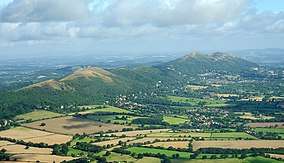Chase (land)
In the United Kingdom a chase is a type of common land used for hunting to which there are no specifically designated officers and laws but instead reserved hunting rights for one or more persons.[1] Similarly, a Royal Chase is a type of Crown Estate by the same description, but where certain rights are reserved for a member of the British Royal Family.

Examples
Examples of chases in England include the Wyre Forest that straddles the border of Worcestershire and Shropshire, Malvern Chase in Worcestershire, and Pensnett Chase near Dudley.
Cannock Chase in Staffordshire has reverted to a chase (which like most chases has been partly reduced in size by settlements). It was in the Middle Ages a Royal Forest,[2] although it merged with a chase around Beaudesert originally belonging (in most of the Middle Ages) to the Bishop of Lichfield.[3]
Rights and history
The Victoria County History describes a chase as:
like a forest, uninclosed, and only defined by metes [houses and farmsteads within] and bounds [hills, highways, watercourses etc];[4] but it could be held by a subject. Offences committed therein were, as a rule, punishable by the common law and not by forest jurisdiction.[5]
Chases, often with more clearings than forests for hunting purposes, or due to their soil type, such as more heath, faced mass inclosure by Private (specifically local) Acts of Parliament primarily throughout the heyday of that type of privatisation 1600–1850. Inclosure converted from to some extent public to private land many chases. The private land after this has in many areas been converted, in part to residential, commercial, industrial or transport infrastructure use, however the chases listed here (see examples) remain largely undiminished by staying a common or by a gift to a public body whether to avoid inheritance tax or motivated by philanthropy.[6]
Misnomers
A chase to which are attached particular officers and laws is legally a forest. So-called deer forests in Scotland are properly speaking chases as are other public "forests" without their own laws but with apportioned hunting rights over the whole area.
Comparative status
Chases and Royal Chases are beneath the status of forests designated as such and Royal Forests respectively. The word "forest" has since the late medieval period come to mean any large woodland. Virtually all of the National Park or AONB forests and significant other forests have officers and laws that apply only to them, making them forests in every sense of the word.[3]
See also
- Ancient woodland
- Hunting in the United Kingdom
- List of forests in the United Kingdom
- Medieval deer park
- Surveyor General of Woods, Forests, Parks, and Chases
References
- Parrish, J. M.; Crossland, John R. (eds.). The Diamond Dictionary. London: Odhams Press Ltd. p. 93.
- Staffordshire Forest Pleas: Introduction, Staffordshire Historical Collections. 5. 1884. pp. 123–135.
- Richards, Bernard (1996), Beaudesert: The Staffordshire Seat of the Marquess of Anglesey
- Edward Coke, The Fourth Part of the Institutes of the Laws of England (1st ed, 1644) quoted verbatim in 1797 https://books.google.co.uk/books?id=ulE0AAAAIAAJ&vq=hampton%20court%20chase&pg=PA301#v=onepage&q=plainly%20appeareth&f=false
- Page, W.H., ed. (1911). A History of the County of Middlesex. Victoria County History. 2. pp. 223–251.
- Chambers, J. D.; Mingay, G. E. (1982). The Agricultural Revolution 1750–1850 (Reprinted ed.). Batsford. pp. 95–99.CS1 maint: ref=harv (link)